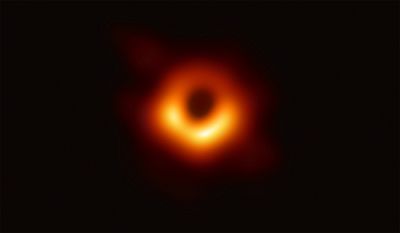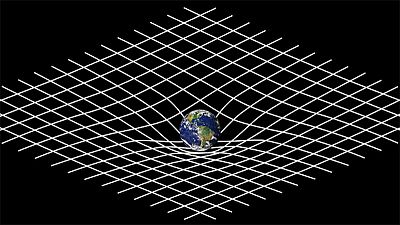New research confirms Einstein's theory of gravity but brings scientists a step closer to the day when it might be supplanted by something new.
Albert Einstein can explain a lot, but maybe not black holes. Scientists believe that within the inky depths of these massive celestial objects, the laws of the universe fold in on themselves, and the elegant model of gravity laid out in Einstein's general theory of relativity breaks down.
They don't know precisely how or where that happens, but a new study brings them closer to the answer.
The study, to be published Aug. 16 in the journal Science, shows that gravity works just as Einstein predicted even at the very edge of a black hole — in this case Sagittarius A*, the supermassive black hole at the center of our Milky Way galaxy. But the study is just the opening salvo in a far-ranging effort to find the point where Einstein's model falls apart.
"We now have the technological capacity to test gravitational theories in ways we've never been able to before," study co-author Jessica Lu, an astrophysicist at the University of California, Berkeley, said. "Einstein's theory of gravity is definitely in our crosshairs."
That means we may be closer to the day when Einstein's relativity is supplanted by some as-yet-undescribed new theory of gravity.
Science
"Newton had a great time for a long time with his description [of gravity], and then at some point it was clear that that description was fraying at the edges, and then Einstein offered a more complete version," said Andrea Ghez, an astrophysicist at UCLA and a co-leader of the new research. "And so today, we're at that point again where we understand there has to be something that is more comprehensive that allows us to describe gravity in the context of black holes."
Changing ideas about gravity
In Newton's view, all objects — from his not-so-apocryphal apple to planets and stars — exert a force that attracts other objects. That universal law of gravitation worked pretty well for predicting the motion of planets as well as objects on Earth — and it's still used, for example, when making the calculations for a rocket launch.
But Newton's view of gravity didn't work for some things, like Mercury's peculiar orbit around the sun. The orbits of planets shift over time, and Mercury's orbit shifted faster than Newton predicted.
Einstein offered a different view of gravity, one that made sense of Mercury. Instead of exerting an attractive force, he reasoned that each object curves the fabric of space and time around them, forming a sort of well that other objects — and even beams of light — fall into. Think of the sun as a bowling ball on a mattress. It creates a depression that draws the planets close.
This new model solved the Mercury problem. It showed that the sun so curves space that it distorts the orbits of nearby bodies, including Mercury. In Einstein's view, Mercury might look like a marble forever circling the bottom of a drain.
Einstein's theory has been confirmed by more than a century of experiments, starting with one involving a 1919 solar eclipse in which the path of light from distant stars was shifted by the sun's intense gravitation — by just the amount Einstein had predicted.
But Ghez and her colleagues wanted to subject Einstein to a more rigorous test. So they watched what happened when light from the star S0-2 passed Sagittarius A*, which is four million times more massive than the sun.
Telltale color change
For the new research, Lu, Ghez and their collaborators used a trio of giant telescopes in Hawaii to watch as a bluish star named S0-2 made its closest approach to Sagittarius A* in its 16-year orbit around the black hole.
If Einstein was right, the black hole would warp space and time in a way that extended the wavelength of light from S0-2. In short, the waves would stretch out as the intense gravity from the black hole drained their energy, causing the starlight's color to shift from blue to red. If the star continued to glow blue, it would give credence to Newton's model of gravity, which doesn't account for the curvature of space and time. If it turned a different color, it would have hinted at some other model of gravity altogether.
Just as Einstein would have predicted, the star glowed red.
"You might say, 'Who cares?' But in fact, no one has looked there," Ghez said. "So we've been able to take a big step forward in terms of exploring a regime that's not been explored before … You know there's a cliff, and you want to get close to that cliff, but you don't know where the drop-off is."
What comes next
Scientists know that at some point in a black hole, Einstein's theory stops working. "The curvature of spacetime is so extreme that Einstein's general relativity fails," said Kip Thorne, a Nobel Prize-winning theoretical physicist at the California Institute of Technology, who wasn't involved in the new research. "We don't understand how it works when the thing you're dealing with is extreme."
This experiment brings scientists a little closer to understanding.
"It's definitely exciting," said Zoltan Haiman, a Columbia University astrophysicist who wasn't involved in the new research. "It's pushing the envelope. This is how we get to some place where we discover [Einstein's] theory no longer works."
Haimain said he was "in awe" of the work researchers had done, likening tracking S0-2 from an observatory on Earth to studying a tree in Paris from a balcony in New York City.
"This test is just the beginning," Lu said. Researchers plan to use a new generation of high-powered instruments to conduct more tests of gravity around black holes. For example, they'll keep an eye on SO-2, to see if its orbit proceeds as Einstein would have expected, or if it takes a different path around Sagittarius A*, suggesting an alternate model of gravity.
In the next 10 years, Lu said, "we should be able to push Einstein's theory of gravity to its limits and hopefully start to see cracks."
What would that mean for science?
"It's very hard to predict how new discoveries in fundamental physics will impact our day-to-day lives," Lu said. "But a new theory of gravity might help us understand how our own universe was born, and how we got to where we are today 13½ billion years later."
Want more stories about science?
- Scientists used a black hole to test Einstein's theory of relativity. Here's the result.
- Scientists finally solve the mystery of weird aurora-like lights in the sky
- Earth's core has been leaking for 2.5 billion years and geologists don't know why
SIGN UP FOR THE MACH NEWSLETTER AND FOLLOW NBC NEWS MACH ON TWITTER, FACEBOOK AND INSTAGRAM.













